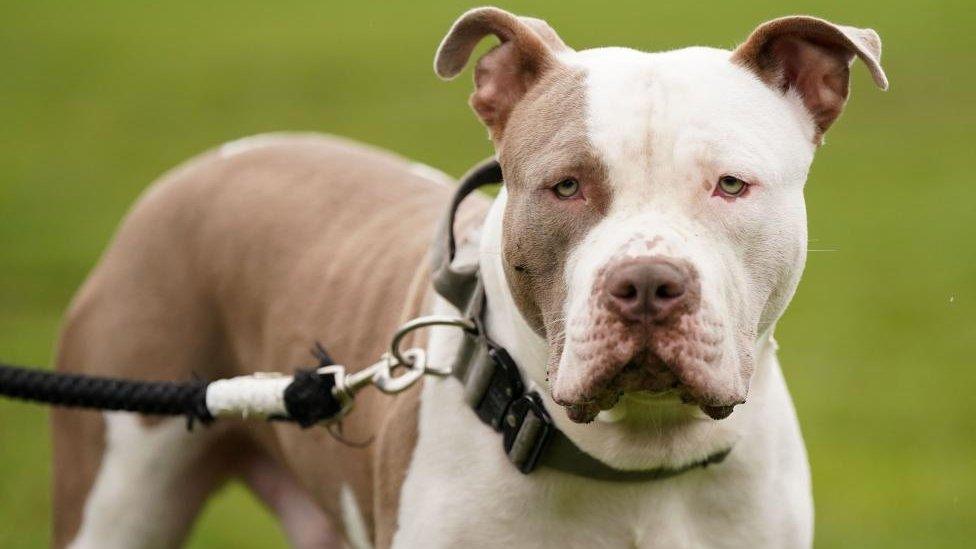What is the XL bully ban and how dangerous are the dogs?
- Published

American bullies have been involved in a series of attacks
Strict rules about owning XL bully dogs have been introduced across the UK.
However, attacks - some fatal - have taken place since the laws were put in place and police say enforcing the ban is a "huge burden" on forces.
What is an American XL bully and how dangerous are they?
An XL bully is the largest kind of American bully dog.
The UK government published guidance to help identify XL bullies,, external which are not a specific breed.
They are described as large dogs "with a muscular body and blocky head, suggesting great strength and power".

Male XL dogs stand from 20in (51cm) high at the shoulder, with female XLs only slightly smaller.
Dogs are considered XLs if they meet the minimum height and a substantial number of other characteristics
There are no official figures for the number in the UK.
How many dog attacks are there and how many people are killed?
There were almost 11,000 hospital admissions for dog bites in England in 2023-24, external, according to NHS England.
Dog attacks resulted in more than 600 hospital admissions in Wales and more than 1,100 in Scotland.
There were seven deaths caused by dog attacks in England and Wales in 2023-24, according to the Office for National Statistics (ONS), external. However, it says this will be an underestimate because of registration delays.
Official figures do not break down the number of attacks or deaths by type of dog.
When the previous government announced the XL bully ban for England and Wales, it said the breed had been "disproportionately involved" in deaths recorded since 2021.
In several cases, XL bullies are known to have killed their owners and children.

Ann Dunn, pictured at a birthday celebration, was found with "catastrophic injuries" in the Liverpool home she shared with seven dogs
How does the American XL bully ban work in England and Wales?
Ownership of American bully XL dogs is restricted under the Dangerous Dogs Act 1991.
Since 31 December 2023, it has been illegal to sell, give away, abandon or breed from an XL bully., external
Since 1 February 2024, it has been a criminal offence to own an XL bully without an exemption certificate.
The government received 61,000 exemption applications before the deadline.
Owners who applied for an exemption had to buy insurance, microchip their dog and pay £92.40 per animal.
Registered dogs must be housed securely, neutered and kept on a lead and muzzled in public - but not at home.
Police can seize unregistered prohibited dogs, and their owners face up to six months in jail and/or an unlimited fine.
What are the rules for American XL bullies in Scotland and Northern Ireland?
Similar restrictions have applied in Scotland since 23 February 2024.
Owners who wished to keep their dogs had to apply for an exemption by 31 July.
In Northern Ireland, American XL bullies have had to be muzzled and kept on a lead in public since 5 July 2024.
The deadline to register for an exemption was 31 December 2024.
The requirements for owners of exempt XL bullies are the same across the whole of the UK.
Anyone breaking the rules in Scotland or Northern Ireland faces up to six months in prison and/or a fine of up to £5,000.
How many people are prosecuted for dog attacks?
In the year to June 2024 - which includes several months after the new rules began - 772 people in England and Wales were prosecuted, external for allowing a dog to injure another person in a public place.
There were 628 convictions.
How has the ban affected police costs?
Enforcing the new rules has sharply increased police costs, according to Chief Constable Mark Hobrough, the National Police Chief Council (NPCC) lead for dangerous dogs.
The NPCC says police forces in England and Wales seized 4,586 suspected banned dogs between February and September 2024 - the first eight months after the rules were introduced. In contrast, 283 were seized in the whole of 2023.

Chief Constable Mark Hobrough said the police have asked for more money to cover the cost of enforcing the ban
The police euthanised 848 during the same period, more than twice the total number destroyed in 2023.
These figures refer to all banned breeds, not just XL bullies.
By April 2025, forces were expected to have spent £25m as a result of the new legislation - including kennel costs and vet bills - a 500% rise on 2018.
Why do some charities oppose the American XL bully ban?
Breed-specific bans do not work and are unfair on responsible dog owners and their pets, according to the Dog Control Coalition.
The body includes Battersea Dogs and Cats Home, the Dogs Trust, the Kennel Club, the RSPCA and the British Veterinary Association.
The group wants a complete overhaul of the Dangerous Dogs Act,, external including tougher penalties for owners who fail to control their dogs.
Which other breeds are banned under the Dangerous Dogs Act?

Lola, classified as pit bull-type, was seized by police in 2019 before her owner was granted an exemption
Four other breeds are banned in the UK under the Dangerous Dogs Act 1991:, external
the American pit bull terrier
the Japanese tosa
the Dogo Argentinos
the Fila Brazileiro
BBC reporter Jordan Davies asks experts why the ban on the American XL bully dog is controversial and what impact it is likely to have in the programme linked below.

